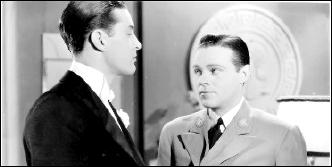Sun 4 Jun 2017
A Movie Review by Dan Stumpf: FOUR HOURS TO KILL (1935).
Posted by Steve under Films: Drama/Romance , Reviews[5] Comments
FOUR HOURS TO KILL. Paramount, 1935. Richard Barthelmess, Joe Morrison, Gertrude Michael, Helen Mack, Dorothy Tree, Roscoe Karns, Ray Milland, Charles C. Wilson, Henry Travers, Noel Madison. Screenplay by Norman Krasna, from his play, “Small Miracles.†Directed by Mitchell Leisen.
A taut and fast-moving Grand Hotel style film, set almost entirely in a theater lobby and done up with superlative Paramount polish.
Gangster Richard Barthelmess is being escorted to the death house by kindly detective Charles C. Wilson, and having four hours to wait between trains, the cop decides they should take in a Broadway show. We never see the show (someone at Paramount had the good sense not to turn this into a musical) but there’s enough drama going on in the lobby to fill four hours and then some.
For starters, the hat check boy (Morrison) is studying to get a law degree and marry his sweetheart (the lovely Helen Mack) but he’s being blackmailed by usherette Dorothy Tree, who wants him to cough up $200 for an abortion or marry her — this film has some surprising elements for a post-code flick.

Meanwhile, no-good Ray Milland is romancing the wealthy and married Gertrude Michael, Roscoe Karns keeps calling the Hospital to see if his wife has delivered their first baby, manager Henry Travers needs money, and Barthelmess is determined to get away and rub out Noel Madison, the hood who squealed on him. Amid all this, check-boy Morrison gets a chance to steal Miss Michael’s diamond pin, but gets caught and…..
The wonder is that writer Krasner and director Leisen manage to keep all this straight (it’s a much easier film to watch than synopsize) and put it across with speed and grace. Of course Mitchell Leisen was a past master of nimble direction but here he shows unusual suppleness in getting his characters onstage and off at opportune moments and moving the camera unobtrusively to catch the action at just the right moment.
Barthelmess’s escape has a fine, gritty quality to it, and there’s real suspense as he sneaks through the opulent corridors toward the end we all knew was coming. Even better though are the moments when the characters seem to really relate to each other, like a quiet conversation on the backstage steps as detective and hood share a cigarette and talk about family life, or the moment when Miss Michael realizes what a rotter Milland really is.
Remarkably, though Leisen and Krasner “open out†the play a bit with excursions to the men’s room, shots of the audience and bits of action outside the theater, it never looks like they’re moving just to be moving. This is a film I’ll remember and one I recommend highly. Still, I’m glad it wasn’t filmed in real time.
June 4th, 2017 at 8:10 pm
I’d have sworn that this is a movie I’d never heard of before. But what do you know, Walter Albert reviewed it here on this blog some four years ago:
https://mysteryfile.com/blog/?p=22399
In one ear and out the other!
June 4th, 2017 at 10:51 pm
I caught this on YouTube and was impressed all around. It manages to be tough and sentimental by turns with Milland getting a rare turn early in his career as a bad guy.
Not that we should be too surprised from Leisen and Krasna.
June 5th, 2017 at 6:59 am
This is a movie I have to see!
Mitchell Leisen is a prestigious director, widely admired by film historians
My favorite Leisen films, so far:
The Eagle and The Hawk
Murder at the Vanities
Artists and Models Abroad
Midnight
The Lady Is Willing
To Each His Own
Golden Earrings
The Mating Season
June 5th, 2017 at 12:24 pm
June 5th, 2017 at 10:28 am
Mike, you really should catch BRIDE OF VENGEANCE